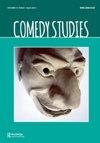Bahlul: an Arab-Islamic clown archetype, a ‘wise fool’, mystic philosophe and a state-bug
Q1 Arts and Humanities
引用次数: 0
Abstract
Abstract Each culture is specific with its clown archetype. In Arab-Islamic culture, the clown archetype is Bahlul. He is a character that has evolved from a real person and has become an archetype of clowning. Bahlul was originally a real person, Abou Wahab Bahlul Ibn Amr, who was an Arab-Islamic mystic philosopher, poet, and lecturer who lived in Iraq and Kabul. He often appeared in the disguise of Bahlul during the time of the Islamic Abbasid Caliphate in order to escape the wrath of rulers and freely criticise society and politics. Abou Wahab Bahlul Ibn Amr transformed himself from a serious character to a social fool, and many would notice that he melts in one pot with the archetype of Darvishe/Darwishe. However, I argue, and through Nietzsche’s philosophy of time, that the Darwishe/Darvish is not a Bahlul, despite their similarities. I insist that a Bahlul can be a Darwish, but a Darwish cannot be a Bahlul. Furthermore, a detailed section will be dedicated to Bahlul, where his banters, religious poems, anecdotes, and political activities in defiance of men in power such as Harun Al-Rachid and his son Al-Ma’mun will be discussed. These men even appreciated Bahlul and sought his advice occasionally.巴鲁尔:阿拉伯-伊斯兰小丑原型、“聪明的傻瓜”、神秘主义哲学家和国家虫
每种文化都有其特有的小丑原型。在阿拉伯-伊斯兰文化中,小丑的原型是巴鲁。他是一个从真人进化而来的角色,已经成为小丑的原型。巴鲁最初是一个真实存在的人,名叫阿布·瓦哈布·巴鲁·伊本·阿姆鲁,他是一位阿拉伯-伊斯兰神秘主义哲学家、诗人和讲师,住在伊拉克和喀布尔。在阿拔斯王朝时期,他为了躲避统治者的愤怒,自由地批评社会和政治,经常伪装成巴鲁尔出现。Abou Wahab Bahlul Ibn Amr将自己从一个严肃的人物转变为一个社会傻瓜,许多人会注意到他与达尔文的原型融合在一起。然而,我认为,通过尼采的时间哲学,达尔文不是一个巴鲁,尽管他们有相似之处。我坚持认为,巴鲁尔可以成为达尔维什,但达尔维什不能成为巴鲁尔。此外,书中还将详细介绍巴鲁的戏谑、宗教诗歌、轶事、反对哈伦·拉希德和他的儿子阿尔·马蒙等当权者的政治活动等内容。这些人甚至很欣赏巴鲁,偶尔也会征求他的意见。
本文章由计算机程序翻译,如有差异,请以英文原文为准。
求助全文
约1分钟内获得全文
求助全文
来源期刊

Comedy Studies
Arts and Humanities-Literature and Literary Theory
CiteScore
0.60
自引率
0.00%
发文量
26
 求助内容:
求助内容: 应助结果提醒方式:
应助结果提醒方式:


